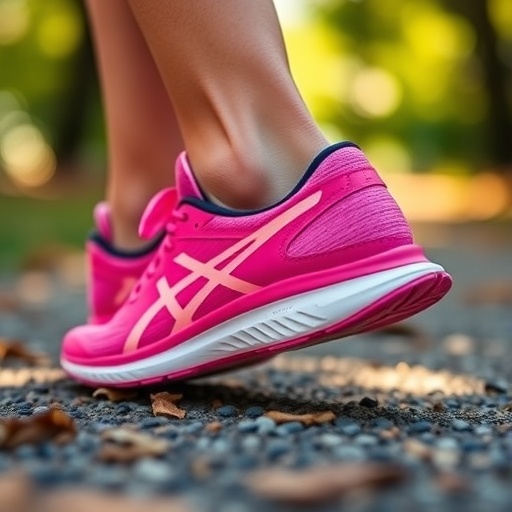For decades, the development of running footwear has followed a seemingly straightforward approach: adapt male shoe designs by merely scaling them down and altering aesthetic elements, often dubbed the ‘shrink it and pink it’ strategy. This method, while widespread, fails to account for the fundamental anatomical and biomechanical differences intrinsic to female runners. A recent qualitative research study published in BMJ Open Sport & Exercise Medicine rigorously challenges this paradigm, highlighting the pressing need for sex- and gender-specific innovations in running shoe design rather than superficial modifications.
The genesis of this oversight lies in the historical dominance of male-centric research and product testing within the sports footwear industry. Investment in running shoes has indeed soared over the past 50 years, targeting injury prevention, enhanced comfort, and performance optimization. Yet, the overwhelming majority of this innovation pipeline and empirical research revolves around male subjects and male anatomies. Consequently, the mold—or ‘last’—used to construct running shoes has remained fundamentally male-oriented. This three-dimensional shoe model shapes not only the external contours but also impacts how a shoe supports the foot dynamically during running.
Critically, most brands perpetuate the practice of producing women’s variants by simply resizing this last and applying gendered colors, predominantly pink hues. Minimal structural or biomechanical alterations accompany this downsizing, which starkly contrasts with the multifaceted needs expressed by female athletes. Recognizing this disconnect, the study in question set out to understand better the nuanced preferences and requirements of women runners spanning a broad demographic spectrum—from recreational joggers to competitive athletes, and spanning a wide age range from 20 to 70 years old.
A cohort of 21 women runners from Vancouver, Canada, was engaged for in-depth discussions, each bringing a wealth of individual running experience ranging from 6 to 58 years. This group included both recreational runners averaging 30 kilometers per week and competitive runners averaging 45 kilometers, some of whom ran during pregnancy or postpartum periods. This diverse sampling was intended to reveal how shoe needs evolve across the female lifespan and under varying physiological and training contexts.
Unanimously, participants emphasized that comfort and injury prevention are paramount in their selection criteria, closely followed by performance attributes. Delving deeper, specifics on comfort preferences emerged: a notably wider toe box allowing natural toe splay contrasted with a narrower heel for secure lockdown, coupled with enhanced cushioning to accommodate softer foot strikes or biomechanical shifts over time. Competitive runners expressed a desire for advanced performance-oriented features like carbon plates but emphasized these must never undermine comfort.
The thematic undercurrent of injury prevention was especially prevalent. Women described an active engagement in sourcing footwear believed to mitigate injury risk, often turning to trusted retailers or specialized personnel for advice. This reflects a broader awareness among female runners regarding the interplay between shoe design and biomechanical stresses that can precipitate overuse injuries. Importantly, the study participants highlighted that shoe requirements are not monolithic, underscoring the necessity for varied designs resonating with specific running contexts like racing, endurance training, speed workouts, or recovery phases following injury.
Of particular interest were insights from runners who were mothers, many of whom reported needing increased shoe size and width alongside augmented support and cushioning during pregnancy and postpartum. This aligns with physiological changes such as ligamental laxity, altered weight distribution, and foot morphology shifts induced by hormonal fluctuations. Furthermore, older competitive runners similarly expressed the need for enhanced cushioning and structural support to accommodate age-associated changes, including diminished plantar fat pad thickness and altered gait mechanics.
Despite the study’s limited sample size and geographic concentration—which the authors transparently acknowledge as limiting global generalizability—the qualitative data paint a compelling narrative of systemic inadequacies in women’s running shoe design. Participants’ experiences of trial-and-error shopping journeys, often devoid of professional guidance or gender-specific solutions, underscore a marketplace ill-equipped to meet female runners’ evolving needs.
The study’s authors articulate an urgent call to action for footwear manufacturers to transcend reductive design approaches. They argue for a paradigm shift toward creating sex- and gender-specific running shoes that embrace women’s distinct foot morphology, biomechanics, and even social preferences, with sensitivity to changes experienced over the lifespan. This holistic perspective shifts focus from mere downscaling of men’s designs to truly innovative, inclusive product development that could redefine women’s running experience, reduce injury rates, and enhance performance potential.
In essence, the research disrupts a long-standing industry orthodoxy, revealing that the enduring ‘shrink it and pink it’ model not only overlooks the complex physical realities of female runners but may also inadvertently contribute to persistent injury patterns and suboptimal performance outcomes. It suggests that only a more nuanced, gender-informed understanding of foot biomechanics and lifecycle changes will usher in the next era of running footwear innovation.
As the footprint of female runners expands globally—both recreationally and competitively—the study’s findings resonate beyond academia into public health and sports technology domains. Greater attention to women-specific biomechanics and morphology can catalyze more personalized and effective footwear solutions. Such progress could have cascading benefits for gait mechanics, injury prophylaxis, and athletic longevity in women, all of which have been historically under-addressed in the sports science and manufacturing sectors.
Notably, this research punctuates a broader dialogue around gender equity in sports equipment design and underscores the intersecting influences of biology, social roles, and athletic aspirations on consumer needs. By advocating for footwear that responds not just to the physical foot but to the lived realities of women runners across different life stages, the study amplifies a call for industry accountability, innovation, and inclusivity.
In summation, this pioneering study elucidates the critical disconnect between existing running shoe designs and the authentic, multifactorial needs of women runners. Its revelations challenge established manufacturing heuristics and ignite vital conversations on the imperative for evidence-based, women-centered design. Moving forward, embracing these insights holds transformative potential for enhancing women’s athletic experiences and reshaping future sports footwear standards on a global scale.
Subject of Research: People
Article Title: “If a shoe had been designed from a woman’s foot, would I be running without getting the injuries?”: running footwear needs and preferences of recreational and competitive women runners across the lifespan
News Publication Date: 14-Oct-2025
Web References: http://dx.doi.org/10.1136/bmjsem-2025-002597
Keywords: Gender bias, Physical exercise, Sports, Recreation, Biomechanics, Morphology, Preventive medicine
Tags: anatomical differences in running shoesbiomechanical needs of female runnerschallenges in women’s sports equipmentequitable design in athletic footweargender-specific footwear designinjury prevention in female athletesinnovation in sports footwearmale-centric product testingperformance optimization for women runnersrunning shoe research and developmentshrink it and pink it approachwomen’s running shoes





